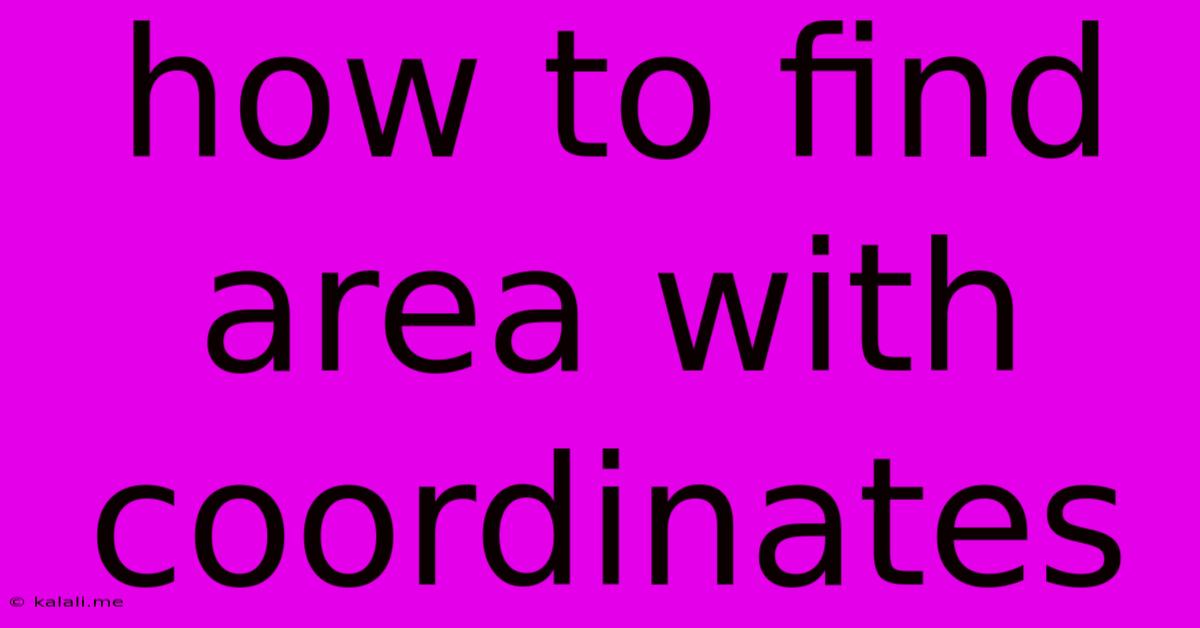How To Find Area With Coordinates
Kalali
Jun 15, 2025 · 3 min read

Table of Contents
How to Find the Area with Coordinates: A Comprehensive Guide
Finding the area of a polygon given its coordinates is a common problem in various fields, from surveying and geography to computer graphics and game development. This guide provides a clear and comprehensive explanation of how to calculate this area, catering to both beginners and those seeking a refresher. We'll cover different methods, explaining the underlying principles and providing practical examples.
Understanding the Problem:
We're dealing with the task of determining the area enclosed by a polygon defined by a set of coordinates. These coordinates represent the vertices (corners) of the polygon. The polygon can be any shape – a triangle, quadrilateral, pentagon, or even more complex irregular shapes. The key is that we have the precise location of each vertex.
Method 1: The Shoelace Formula (Gauss's Area Formula)
This is arguably the most efficient and widely used method for calculating the area of a polygon given its coordinates. It's especially useful for polygons with many vertices. The formula is:
Area = 0.5 * |(x₁y₂ + x₂y₃ + ... + xₙy₁ ) - (y₁x₂ + y₂x₃ + ... + yₙx₁)|
Where:
- (xᵢ, yᵢ) are the coordinates of the i-th vertex.
- n is the number of vertices.
- |...| denotes the absolute value (since area is always positive).
Example:
Let's consider a triangle with vertices A(1, 1), B(4, 5), and C(7, 2). Applying the Shoelace formula:
Area = 0.5 * |(15 + 42 + 71) - (14 + 57 + 21)| Area = 0.5 * |(5 + 8 + 7) - (4 + 35 + 2)| Area = 0.5 * |20 - 41| Area = 0.5 * |-21| Area = 10.5 square units
Method 2: Dividing into Triangles (for Irregular Polygons)
For irregular polygons that are difficult to handle directly with the Shoelace formula, you can divide the polygon into several triangles. Calculate the area of each triangle individually using the standard triangle area formula (0.5 * base * height) or Heron's formula, and then sum up the areas. This method can be more time-consuming, but it's reliable for any polygon shape. However, you'll need to determine the base and height for each triangle, which may require additional calculations.
Method 3: Using Software and Programming
Many software applications and programming libraries offer built-in functions to calculate polygon areas from coordinates. Geographic Information Systems (GIS) software, CAD programs, and various programming languages (like Python with libraries like Shapely or GeoPandas) have tools specifically designed for this purpose. This is often the most efficient approach for large datasets or complex polygons.
Choosing the Right Method:
- Shoelace Formula: The most efficient and elegant method for most polygons.
- Triangle Division: Suitable for irregular polygons where the Shoelace formula is difficult to apply directly.
- Software/Programming: Ideal for large datasets, complex polygons, or when automation is required.
Further Considerations:
- Coordinate System: Ensure all coordinates are in the same system (e.g., Cartesian coordinates).
- Order of Vertices: The Shoelace formula requires the vertices to be listed in either clockwise or counterclockwise order. Reversing the order will simply change the sign of the area.
- Accuracy: Numerical precision can affect the accuracy of the calculation, especially for polygons with many vertices or very small areas.
By understanding these methods and choosing the appropriate one based on the complexity of your polygon, you can accurately and efficiently calculate its area from its coordinates. Remember to always double-check your calculations and consider using software tools for large datasets or complex shapes.
Latest Posts
Latest Posts
-
How Many Main Colours Are There
Jun 15, 2025
-
The Perimeter Of A Rectangle Is 30 Cm
Jun 15, 2025
-
What Is The Lcm Of 14 And 24
Jun 15, 2025
-
The San Andreas Fault Is An Example Of A
Jun 15, 2025
-
Is A Snake A Tertiary Consumer
Jun 15, 2025
Related Post
Thank you for visiting our website which covers about How To Find Area With Coordinates . We hope the information provided has been useful to you. Feel free to contact us if you have any questions or need further assistance. See you next time and don't miss to bookmark.